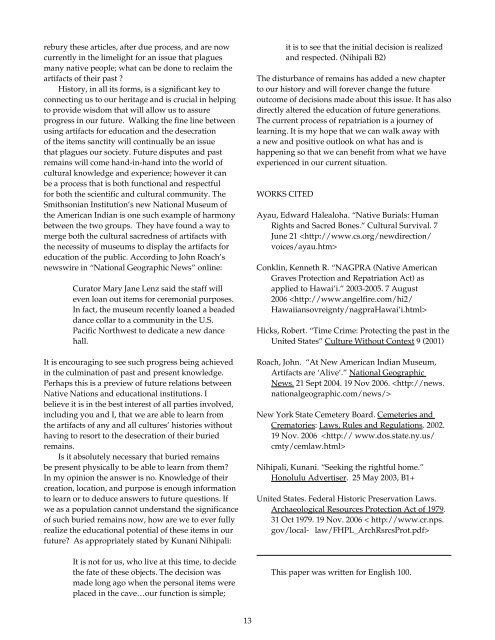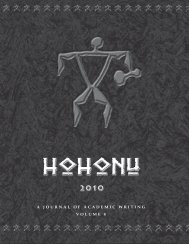A JOURNAL OF ACADEMIC WRITING VOLUME 5
A JOURNAL OF ACADEMIC WRITING VOLUME 5
A JOURNAL OF ACADEMIC WRITING VOLUME 5
You also want an ePaper? Increase the reach of your titles
YUMPU automatically turns print PDFs into web optimized ePapers that Google loves.
ebury these articles, after due process, and are now<br />
currently in the limelight for an issue that plagues<br />
many native people; what can be done to reclaim the<br />
artifacts of their past ?<br />
History, in all its forms, is a significant key to<br />
connecting us to our heritage and is crucial in helping<br />
to provide wisdom that will allow us to assure<br />
progress in our future. Walking the fine line between<br />
using artifacts for education and the desecration<br />
of the items sanctity will continually be an issue<br />
that plagues our society. Future disputes and past<br />
remains will come hand-in-hand into the world of<br />
cultural knowledge and experience; however it can<br />
be a process that is both functional and respectful<br />
for both the scientific and cultural community. The<br />
Smithsonian Institution’s new National Museum of<br />
the American Indian is one such example of harmony<br />
between the two groups. They have found a way to<br />
merge both the cultural sacredness of artifacts with<br />
the necessity of museums to display the artifacts for<br />
education of the public. According to John Roach’s<br />
newswire in “National Geographic News” online:<br />
Curator Mary Jane Lenz said the staff will<br />
even loan out items for ceremonial purposes.<br />
In fact, the museum recently loaned a beaded<br />
dance collar to a community in the U.S.<br />
Pacific Northwest to dedicate a new dance<br />
hall.<br />
It is encouraging to see such progress being achieved<br />
in the culmination of past and present knowledge.<br />
Perhaps this is a preview of future relations between<br />
Native Nations and educational institutions. I<br />
believe it is in the best interest of all parties involved,<br />
including you and I, that we are able to learn from<br />
the artifacts of any and all cultures’ histories without<br />
having to resort to the desecration of their buried<br />
remains.<br />
Is it absolutely necessary that buried remains<br />
be present physically to be able to learn from them?<br />
In my opinion the answer is no. Knowledge of their<br />
creation, location, and purpose is enough information<br />
to learn or to deduce answers to future questions. If<br />
we as a population cannot understand the significance<br />
of such buried remains now, how are we to ever fully<br />
realize the educational potential of these items in our<br />
future? As appropriately stated by Kunani Nihipali:<br />
It is not for us, who live at this time, to decide<br />
the fate of these objects. The decision was<br />
made long ago when the personal items were<br />
placed in the cave…our function is simple;<br />
13<br />
it is to see that the initial decision is realized<br />
and respected. (Nihipali B2)<br />
The disturbance of remains has added a new chapter<br />
to our history and will forever change the future<br />
outcome of decisions made about this issue. It has also<br />
directly altered the education of future generations.<br />
The current process of repatriation is a journey of<br />
learning. It is my hope that we can walk away with<br />
a new and positive outlook on what has and is<br />
happening so that we can benefit from what we have<br />
experienced in our current situation.<br />
WORKS CITED<br />
Ayau, Edward Halealoha. “Native Burials: Human<br />
Rights and Sacred Bones.” Cultural Survival. 7<br />
June 21 <br />
Conklin, Kenneth R. “NAGPRA (Native American<br />
Graves Protection and Repatriation Act) as<br />
applied to Hawai’i.” 2003-2005. 7 August<br />
2006 <br />
Hicks, Robert. “Time Crime: Protecting the past in the<br />
United States” Culture Without Context 9 (2001)<br />
Roach, John. “At New American Indian Museum,<br />
Artifacts are ‘Alive’.” National Geographic<br />
News. 21 Sept 2004. 19 Nov 2006. <br />
New York State Cemetery Board. Cemeteries and<br />
Crematories: Laws, Rules and Regulations. 2002.<br />
19 Nov. 2006 <br />
Nihipali, Kunani. “Seeking the rightful home.”<br />
Honolulu Advertiser. 25 May 2003, B1+<br />
United States. Federal Historic Preservation Laws.<br />
Archaeological Resources Protection Act of 1979.<br />
31 Oct 1979. 19 Nov. 2006 < http://www.cr.nps.<br />
gov/local- law/FHPL_ArchRsrcsProt.pdf><br />
This paper was written for English 100.
















